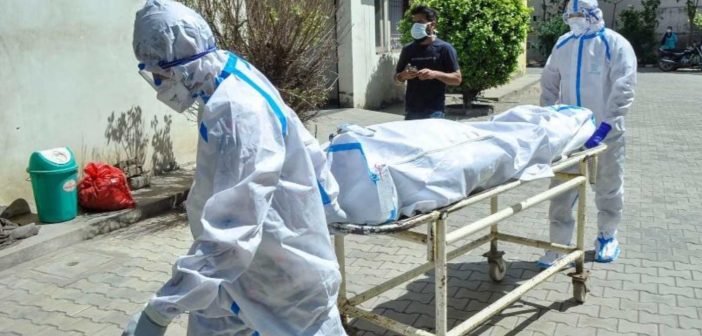SRS data for 22 major states (including Delhi) revealed that 16 of these states recorded their highest ever death rate in 2021 in the 2011 to 2021 period. Additionally, all 22 states reported higher death rates in 2021 than in 2019 and 2020, thus demonstrating the grave impact of the COVID-19 pandemic.
In the previous stories (here & here), we explored the trends in deaths registered across India and in the States and Union Territories (UTs), focusing on excess deaths that may be attributable to COVID-19 in 2021, based on Medical Certification of Causes of Deaths (MCCD) annual reports.
In this story, we look at the All-India and State-wise death trends for major states, using data from the Sample Registration System (SRS) annual reports.
Note: The state-wise analysis is limited to 22 major states as defined in the SRS annual reports. Further, for the purpose of analysis, the Union Territory (UT) of Delhi is referred to as a State in the story.
What is the difference between MCCD and SRS?
The MCCD is a system implemented under the Registration of Births and Deaths (RBD) Act, 1969, mandating that every death in India be medically certified by a registered practitioner. The data on registered and medically certified deaths each year is published in the MCCD’s annual report. Therefore, only the registered deaths data is covered through this system.
SRS is a nationwide demographic survey conducted through continuous enumeration and biannual surveys in selected rural and urban sample units. It is conducted to provide reliable annual estimates of birth, death, and infant mortality rates. While it doesn’t provide cause-of-death data, SRS serves as a tool for tracking population trends and evaluating health and family welfare programs. The major limitation in this system is it provides large-scale demographic data based on the results of sample surveys.
However, despite their limitations, both these systems are seen as crucial tools to draw insights into disease patterns, mortality trends, and public health needs.
16 out of 22 Major States recorded the Highest Ever Death Rates in 2021 since 2011
Mirroring the trends observed in registered deaths from the MCCD data, SRS data also reflects a sharp increase in mortality during 2021. Based on survey results, SRS calculates estimated death rates — often referred to as Crude Death Rates (CDR) — using the following formula:
CDR = (Number of deaths/Mid-year population) ×1000
According to this metric, India’s death rate in 2011 stood at 7.1. It then declined gradually to 6.2 in 2018 and further to 6 in both 2019 and 2020. However, in 2021, the death rate increased to 7.5, marking the highest level since 2011.
SRS data for 22 major states (including Delhi) revealed that 16 of these states recorded their highest ever death rates in 2021 in the 2011 to 2021 period.
Additionally, all 22 states reported higher death rates in 2021 than in 2019 and 2020, thus demonstrating the grave impact of the COVID-19 pandemic.
Compared to 2011, a Higher Death Rate was reported in 13 States for females and 19 States for males in 2021
Some studies and reports (here & here) have debated global gender imbalances in COVID-19 cases and deaths, with differing conclusions. For India, the SRS data indicated a likely imbalance when gender-wise comparison of death rates is made.
At the All-India level, the female death rate was 6.3 in 2011, 5.4 in 2019, and 5.4 in 2020. However, 2021 marked the highest death rate for females during the 2011–2021 period, at 6.4. A similar trend was observed for males, whose death rate was 7.8 in 2011, 6.5 in 2019, and 6.6 in 2020. Then it rose sharply to 8.5 in 2021, the highest in the same period.
A state-wise comparison across 22 major states shows that in 2021, the female death rate was higher than in 2011 in 13 states, higher than in 2019 in 18 states, and higher than in 2020 in 19 states. Overall, 10 of these 22 states recorded their highest female death rate in 2021 since 2011. For males, the death rate in 2021 was higher than in 2011 in 19 states, and higher than in both 2019 and 2020 in all 22 states. Notably, 19 out of 22 states recorded their highest male death rate in 2021 since 2011.
Historically, the male death rate in India has been consistently higher than that for females. This pattern persists across states. While the disparity in the number of states reporting record-high death rates for men and women in 2021 hints at a gender imbalance in COVID-19 mortality, these observations are not conclusive.
Compared to 2019 & 2020, all age groups between 30 years to 69 years recorded an increased share of deaths
The SRS also provides age-wise death share data, categorising it into five-year intervals. According to this data, all age groups from below one year up to 24 years showed a decline in the share of total deaths in 2021 when compared to 2019. A similar trend was observed when compared with 2020, except for the 1–4 years age group, which accounted for a share of 0.9% in both years.
The 25–29 years age group accounted for a consistent share of 2.1% in both 2019 and 2021, though it had risen slightly to 2.3% in 2020. From the 30–34 age group onward, all age segments up to 70 years recorded an increase in the share of deaths in 2021 compared to both 2019 and 2020. The 70–74 years group showed a marginal decline from 11.3% in 2020 to 10.8% in 2021, but this was still higher than its 2019 share of 10.3%, indicating a net increase over the pre-pandemic year. Similarly, the 75–79 years group registered a decrease in its 2021 share compared to 2019, but an increase over 2020. The 80–84 years group, however, recorded a rise in its share of deaths in 2021 over both 2019 and 2020.
Compared to 2019, 10 major states showed an increase in share of deaths in age groups between 25 to 74 years in 2021
The increase in the share of deaths among age groups between 25 to 74 years in 2021 compared to 2019 is also reflected across the major states. Among the 22 major states, not a single state showed an increase in the share of deaths for the age groups below 1 year and 0–4 years. However, increases were noted in 2 states for the 1–4 age group, 6 states for 5–9 years, 9 states for 10–14 years, 4 states for 15–19 years, and 9 states for the 20–24 age group.
From here, the number of states with an increase in share went into double digits with 10 states for age group 25 to 29, 12 for 30 to 34, 15 for 35 to 39, and so on. The highest was observed for the age groups 50 to 54 and 60 to 64 years, with 17 states each.
To sum up, the SRS data also aligns with MCCD data and indicates a strong possibility of excess COVID-19 deaths compared to the officially reported figures.



